Pet Wellness Guides > Cat Epilepsy: Symptoms and Treatment
Cat Epilepsy: Symptoms and Treatment
Posted: 11/06/2023 | BY: Erin Cain | Categories: Uncategorized
November is National Epilepsy Awareness Month, and we’re going to look at the role epilepsy plays in a cat’s health. What is cat epilepsy? Cat epileptic seizures are due to abnormal electrical activity in the brain. It can happen when a cat experiences specific triggers, such as stress or trauma. Cat epilepsy, or feline idiopathic epilepsy, is one of the most common causes of seizures in cats. However, there are other possible origins for this condition in felines. If you have a cat with seizures, it can be very stressful. You want to do everything in your power to help them and get them feeling better as soon as possible. Here we will talk about what causes cat epileptic seizures, how to recognize one if they occur, and what treatments exist for cats who suffer from epilepsy.
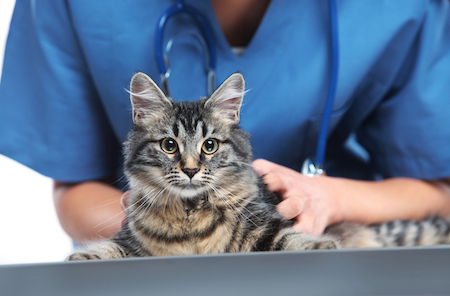
What is feline epilepsy?
Epilepsy is a condition in which seizures happen repeatedly. While it can affect people and cats, feline epilepsy is rare and often difficult to source. When there’s no apparent cause for a cat to have seizures, they are diagnosed with idiopathic epilepsy.
To simplify seizures and epilepsy, the causes of these episodes are due to a primary lesion in the cat’s brain. Secondary-systemic epilepsy can also develop and is more common with cats; thus, that determination will require veterinary diagnostics. The three types of epilepsy that may affect cats are:
Primary epilepsy
Primary or idiopathic epilepsy is a type of seizure disorder found in dogs and cats. The cause for this condition isn’t known. Still, it’s estimated that one out of four cats with seizures suffers from this type of illness.
A diagnosis of primary epilepsy means that the episodes in question were caused by functional problems within your kitty’s brain instead of structural issues. Chemical imbalances between excitatory signals (those responsible for causing action) and inhibitory ones (that stop actions) are connected with primary epilepsy. Cats with this seizure type begin showing symptoms when they’re young adults, but it can be diagnosed in cats of any age.
Symptomatic epilepsy
Symptomatic epilepsy is a type of disorder that occurs secondary to an underlying brain lesion. The causes for this condition include neoplasia, infectious or immune-mediated meningoencephalitis, and vascular events (stroke). There are also cases where cats develop symptomatic epileptic traits from congenital disabilities such as congenital abnormalities.
Cats with symptomatic epilepsy are more likely to develop feline infectious peritonitis (FIP), toxoplasmosis, neoplasia, or lymphoma. These cats are also at risk for developing hemorrhagic infarcts and hemorrhagic strokes, as both types of stroke cause disruption in the brain’s blood supply.
Probable symptomatic epilepsy
Probable symptomatic epilepsy describes an instance in which a brain lesion cannot be identified but is strongly suspected by the veterinarian. After anesthesia, some cats develop seizures due to the stress of being put under. These seizures are often diagnosed as “probable symptomatic epilepsy,” even if their actual lesion causing these fits cannot be identified.

A seizure is a sudden, uncontrolled electrical disturbance in a cat’s brain. There are three types of epileptic seizures that a cat with epilepsy may experience:
Generalized
Generalized seizures, also called grand mal seizures, are usually the easiest seizure to recognize. They often occur suddenly but only last around 1 – 3 minutes. These seizures include:
- rigid limbs
- violent shaking
- paddling or running movements
- chomping teeth
- snapping the jaw
- collapse
- loss of awareness
- uncontrollable salivation, urination, and defecation.
Multiple seizures occurring within a short time of each other are referred to as a cluster.
Focal
Focal seizures, also called partial seizures, are the most common type of seizure in cats. Unfortunately, this situation makes them hard to diagnose, and their symptoms can be confused with other illnesses or conditions.
A focal seizure affects only a portion of the brain within one hemisphere. These episodes don’t typically lead to loss of consciousness. These seizures can progress into generalized seizures later on in life if they’re not properly treated or controlled with medication.
Reactive
Reactive seizures in cats respond to an underlying cause or condition, such as diabetes or liver disease. These seizures also happen when a cat has been exposed to a poison or toxin. In these cases, the cat will only seize once. Technically, reactive seizures aren’t seizures but reactions caused by extracranial disease.
What causes seizures in cats?
Seizures in cats tend to be much rarer than those experienced by dogs. Unlike epilepsy which tends to occur as an inherited condition among canines, seizures in cats may also stem from disease or injury within their brain. Typical causes for this kind of seizure include issues with intracranial causes and functioning, such as congenital disabilities, head trauma, tumor, stroke, or infection. Brain tumors like meningiomas are the primary cause of epilepsy in cats under age 10.
Outside factors such as toxins and poisons may also contribute to seizures in felines. Flea and tick medications and shampoos or sprays that contain pyrethrin are dangerous for cats. This chemical is often found in dog tick and flea treatments and should not be used on cats at all.
Unfortunately, recent research found that 22% – 41% of cats have epilepsy without a known cause. Even medical testing and neurological work revealed no blood-borne or structural cause of the condition.
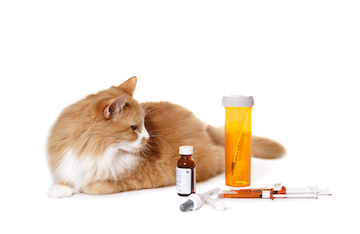
What are the symptoms of feline epilepsy?
Depending on the type of seizure your cat experiences, there can be a wide variety of signs and symptoms.
For a generalized seizure
- convulsions
- paddling
- limb rigidity
- abnormal vocalization
- loss of bowel and urinary control
- loss of consciousness
- excessive salivation
- facial twitching
- behavioral changes
For a partial seizure (focal)
- aggression
- tail-chasing
- biting
- shadow chasing
- behavioral changes
How are cats diagnosed with epilepsy?
The first step in diagnosing a seizure disorder involves discussing your cat’s symptoms with your veterinarian and having them perform an examination. Blood tests are often required, but a vet can’t always rule out other causes for seizures or abnormal results that may occur, such as metabolic disorders. Additional testing might be needed depending on what is causing the attacks. Some forms of epilepsy have been found to accompany brain lesions or tumors. In contrast, others don’t seem linked with tumor presence at all.
Generally, the veterinarian will run a battery of tests on your cat, including blood tests, advanced imaging (MRI), spinal fluid analysis, and urine tests.
Primary epilepsy
Primary or idiopathic epilepsy is a type of seizure disorder found in dogs and cats. The cause for this condition isn’t known. Still, it’s estimated that one out of four cats with seizures suffers from this type of illness. A diagnosis of primary epilepsy means that the episodes in question were caused by functional problems within your kitty’s brain instead of structural issues. Chemical imbalances between excitatory signals (those responsible for causing action) and inhibitory ones (that stop actions) are connected with primary epilepsy. Cats with this seizure type begin showing symptoms when they’re young adults, but it can be diagnosed in cats of any age.
Symptomatic epilepsy
Symptomatic epilepsy is a type of disorder that occurs secondary to an underlying brain lesion. The causes for this condition include neoplasia, infectious or immune-mediated meningoencephalitis, and vascular events (stroke). There are also cases where cats develop symptomatic epileptic traits from congenital disabilities such as congenital abnormalities.
Cats with symptomatic epilepsy are more likely to develop feline infectious peritonitis (FIP), toxoplasmosis, neoplasia, or lymphoma. These cats are also at risk for developing hemorrhagic infarcts and hemorrhagic strokes, as both types of stroke cause disruption in the brain’s blood supply.
Probable symptomatic epilepsy
Probable symptomatic epilepsy describes an instance in which a brain lesion cannot be identified but is strongly suspected by the veterinarian. After anesthesia, some cats develop seizures due to the stress of being put under. These seizures are often diagnosed as “probable symptomatic epilepsy,” even if their actual lesion causing these fits cannot be identified.
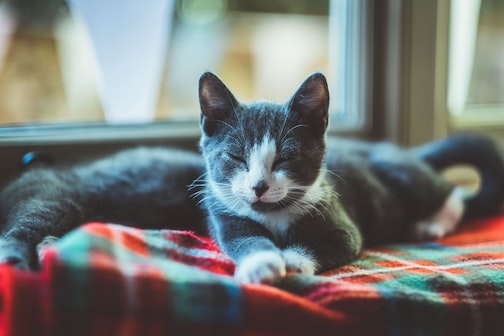
A seizure is a sudden, uncontrolled electrical disturbance in a cat’s brain. There are three types of epileptic seizures that a cat with epilepsy may experience:
Generalized
Generalized seizures, also called grand mal seizures, are usually the easiest seizure to recognize. They often occur suddenly but only last around 1 – 3 minutes. These seizures include:
rigid limbs, violent shaking, paddling or running movements, chomping teeth, snapping the jaw, collapse, loss of awareness, uncontrollable salivation, urination, and defecation. Multiple seizures occurring within a short time of each other are referred to as a cluster.
Focal
Focal seizures, also called partial seizures, are the most common type of seizure in cats. Unfortunately, this situation makes them hard to diagnose, and their symptoms can be confused with other illnesses or conditions.
A focal seizure affects only a portion of the brain within one hemisphere. These episodes don’t typically lead to loss of consciousness. These seizures can progress into generalized seizures later on in life if they’re not properly treated or controlled with medication.
Reactive
Reactive seizures in cats respond to an underlying cause or condition, such as diabetes or liver disease. These seizures also happen when a cat has been exposed to a poison or toxin. In these cases, the cat will only seize once. Technically, reactive seizures aren’t seizures but reactions caused by extracranial disease.
What causes seizures in cats?
Seizures in cats tend to be much rarer than those experienced by dogs. Unlike epilepsy which tends to occur as an inherited condition among canines, seizures in cats may also stem from disease or injury within their brain. Typical causes for this kind of seizure include issues with intracranial causes and functioning, such as congenital disabilities, head trauma, tumor, stroke, or infection. Brain tumors like meningiomas are the primary cause of epilepsy in cats under age 10.
Outside factors such as toxins and poisons may also contribute to seizures in felines. Flea and tick medications and shampoos or sprays that contain pyrethrin are dangerous for cats. This chemical is often found in dog tick and flea treatments and should not be used on cats at all.
Unfortunately, recent research found that 22% – 41% of cats have epilepsy without a known cause. Even medical testing and neurological work revealed no blood-borne or structural cause of the condition.
What are the symptoms of feline epilepsy?
Depending on the type of seizure your cat experiences, there can be a wide variety of signs and symptoms.
For a generalized seizure
- convulsions
- paddling
- limb rigidity
- abnormal vocalization
- loss of bowel and urinary control
- loss of consciousness
- excessive salivation
- facial twitching
- behavioral changes
For a partial seizure (focal)
- aggression
- tail-chasing
- biting
- shadow chasing
- behavioral changes
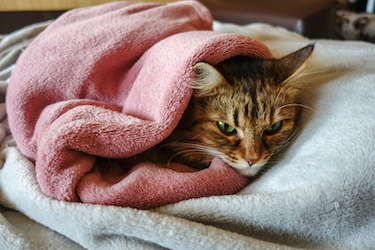
How should you handle your cat’s seizures?
A cat’s seizure can be a scary experience for both pet owners and humans, but they are rarely life-threatening. You do not need to take your furry friend immediately to an emergency clinic if the seizure only lasts one or two minutes.
If you suspect that your cat is having a seizure, remain calm. First, look at the clock and note when the event starts. Next, make sure your cat isn’t going to hurt herself in any way. Avoid moving the kitty if possible; however, if the cat is in an unsafe place, be ready with a blanket to protect your arms from biting and scratching. Keep other animals away from the cat during the seizure. Cats can become disoriented after an episode, and they need a quiet space to reorient themselves.
You may be wondering what to do during a cat seizure. Don’t touch your cat unless they’re at risk of hurting themselves, such as if she is about to fall downstairs. Avoid touching your cat during the seizure, as the cat will be disoriented and afraid and may scratch or bite you.
However, suppose an individual cat has multiple seizures with little time in between them. In that case, these recurrent seizures might indicate that something more serious is happening. If your cat’s seizure lasts more than three minutes, call your veterinarian or emergency facility to describe the cluster seizures as soon as possible.
How are cats diagnosed with epilepsy?
The first step in diagnosing a seizure disorder involves discussing your cat’s symptoms with your veterinarian and having them perform an examination. Blood tests are often required, but a vet can’t always rule out other causes for seizures or abnormal results that may occur, such as metabolic disorders. Additional testing might be needed depending on what is causing the attacks. Some forms of epilepsy have been found to accompany brain lesions or tumors. In contrast, others don’t seem linked with tumor presence at all.
Generally, the veterinarian will run a battery of tests on your cat, including blood tests, advanced imaging (MRI), spinal fluid analysis, and urine tests.
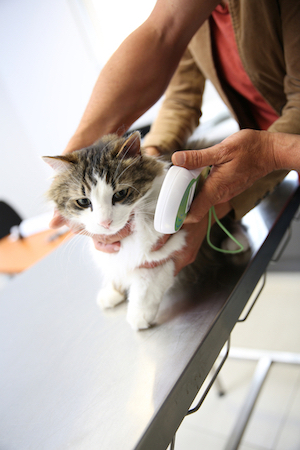
How is epilepsy treated in cats?
If your cat is experiencing seizures, a veterinarian must implement treatment since the frequency and severity of these events can lead to further brain damage. In cases where the cause of seizures is unknown or untreatable, a veterinarian will review your cat’s health history. They may prescribe an antiepileptic medication for your cat to reduce and control future seizures.
The best treatment for seizures caused by a toxin is to remove the toxic substance from the body. Treatment may involve bathing or administering certain medications to improve your cat’s health and life expectancy. There should be only a single seizure associated with exposure to toxins.
Successful treatment of epilepsy is a reduction in the number and severity of seizures. Total seizure prevention is rare, but your cat can still live a normal life even with occasional lapses.
Treatment and warnings
It’s essential to keep your feline friend safe and healthy. If your cat is diagnosed with epilepsy, you will need to ensure the medication is taken every day. Here are a few rules:
- Follow the dosage and timing instructions on your cat’s medications to ensure successful treatment. The timing of seizure medication is a crucial element in controlling feline epilepsy.
- Keep seizure medications in a safe place where children and other animals cannot access them.
- Do not run out of medicine. Your cat could experience uncontrollable seizures if you suddenly stop giving them this drug.
- Give your kitty the best possible care by consulting a veterinarian before giving them any other medications or supplements. Your cat’s health depends on it!
Let pet insurance help you help your epileptic cat.
Does pet insurance cover feline epilepsy? The answer is yes, as long as epilepsy is not a pre-existing condition. That’s one of many reasons why having a pet insurance plan before your cat shows signs of illness is essential for cat parents. A pet insurance policy before your cat develops epilepsy will cover up to 90% of veterinary appointments, diagnostic tests, treatments, and medications, after your deductible.
Pet Insurance Review uses your pet’s needs and your budget to find the perfect plan that will provide your cat with the coverage she deserves. Get a free pet insurance quote now and know that your cat is covered in the future.
References:
1. Epilepsy Foundation. (2021). National Epilepsy Awareness Month. Retrieved from https://www.epilepsy.com/make-difference/public-awareness/national-epilepsy-awareness-month
2. Parent, J. (2010). Work-Up, Therapy and Complications of Seizures in Cats. Retrieved from https://www.vin.com/apputil/content/defaultadv1.aspx?pId=11310&catId=33762&id=4516341
3. Paul, M. (2015). Cat Seizures and Epilepsy 101. Retrieved from https://www.pethealthnetwork.com/cat-health/cat-diseases-conditions-a-z/cat-seizures-and-epilepsy-101
4. ASPCAPro. (2021). Most Common Causes of Toxin Seizures in Cats. Retrieved from https://www.aspcapro.org/resource/most-common-causes-toxin-seizures-cats
DisclaimerThe information contained on this blog is intended for informational and educational purposes only and should not be construed as medical advice. It is not a substitute for professional veterinary care. Always consult with your veterinarian before making any changes to your pet's health care or treatment plan.
The authors of this blog are not veterinarians and do not claim to be experts in pet health. The information provided here is based on our own experiences and research, as well as information from reputable sources. However, we cannot guarantee the accuracy or completeness of this information.
We encourage you to do your own research and consult with your veterinarian before making any decisions about your pet's health.